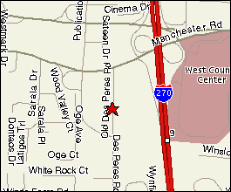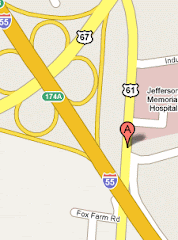What is the sound of two hands clapping? We have no idea. But we do know exactly how a prosthetic pin sounds when it clicks into the locking mechanism of a custom socket. Now, you can too. Listen on NPR's All Things Considers as Physical Therapist Sandy Diamond describes why she loves this sound, part of their series Sound Clips.
Wednesday, August 29, 2007
Thursday, August 23, 2007
John Lartonoix, ABC Certified Orthotist
 John Lartonoix (a French name pronounced Lar-ton-wah) became an ABC Certified Orthotist is 2001. To prepare him for this exciting career, John earned a bachelor degree in Exercise Science from Appalachian State University and an associates degree for Physical Therapy Assistant. Then, he interned with an O&P company in the St.Louis area where he met and worked side by side with Jon Wilson, now P&O Care's Clinical Director.
John Lartonoix (a French name pronounced Lar-ton-wah) became an ABC Certified Orthotist is 2001. To prepare him for this exciting career, John earned a bachelor degree in Exercise Science from Appalachian State University and an associates degree for Physical Therapy Assistant. Then, he interned with an O&P company in the St.Louis area where he met and worked side by side with Jon Wilson, now P&O Care's Clinical Director.
In 2000, John and Jon both attended Northwestern Medical School's Orthotic Program and often talked about working together in the future. However, after graduating John Lartonoix took a residency in Columbus, Ohio, for Columbus Orthopedic, and Jon Wilson returned to St.Louis to form P&O Care. Columbus Orthopedic was later purchased by the Hanger Corporation and was an extremely respected practice. The office serviced all local hospitals including Children's Hospital and the Ohio State University Hospital.
In his patient care, John says he was lucky enough to be exposed to most aspects of the orthotic field. "I worked closely with several doctors from the Children's Hospital developing a strong pediatric background. In 2006 P&O Care developed a need for a certified Orthotist, and I was looking for new career experiences. After meeting with Jon Wilson and Jim Weber, CEO of P&O Care, I found what I was looking for. P&O Care is a group of wonderful people who make for an amazing team. I see such a variety of patients each day, which allows me to help people in many different ways. Being part of the P&O Care team enables me to do my job with care and pride."
Tuesday, August 21, 2007
Rocket-powered Mechanical Arm Could Revolutionize Prosthetics
 [This is no joke.]
[This is no joke.]
Science Daily — Combine a mechanical arm with a miniature rocket motor: The result is a prosthetic device that is the closest thing yet to a bionic arm.
A prototype of this radical design has been successfully developed and tested by a team of mechanical engineers at Vanderbilt University as part of a $30 million federal program to develop advanced prosthetic devices.
"Our design does not have superhuman strength or capability, but it is closer in terms of function and power to a human arm than any previous prosthetic device that is self-powered and weighs about the same as a natural arm," says Michael Goldfarb, the professor of mechanical engineering who is leading the effort.
Read the full original article at http://www.sciencedaily.com/releases/2007/08/070820130638.htm.
Friday, August 17, 2007
Introducing Shawn McAdams
P&O Care is excited to announce the addition of orthotist Shawn McAdams, who brings warm patient care and highly skilled craftsmanship to our profession. Shawn just completed his residency in orthotics with C. H. Martin Co. in Macon, GA. He graduated from Northwestern Medical School’s Orthotics and Prosthetics Practitioner Program in 2005, and he has worked in the field since he became an orthotic and prosthetic technician in 2001. This December, Shawn will be taking his board exams for ABC certification in orthotics. Until then, he will be supervised in all his patient care by P&O Care’s Lead Orthotist, Dennis Richards, who has been an ABC Certified Orthotist since 2004.
Wednesday, August 15, 2007
Farewell, Jen
 On August 24, 2007, P&O Care will sadly say goodbye to Jennifer Burget, one of our talented ABC Certified Orthotists. Ms. Burget has worked with us since 2005. She will be working at the Jefferson Barracks VA Hospital as an orthotist treating our veterans. Next Friday, prosthetist Greg Doerr is hosting a party for the company and our spouses or dates to celebrate Jen's time with us and bid her farewell. Manny will be blending the margaritas.
On August 24, 2007, P&O Care will sadly say goodbye to Jennifer Burget, one of our talented ABC Certified Orthotists. Ms. Burget has worked with us since 2005. She will be working at the Jefferson Barracks VA Hospital as an orthotist treating our veterans. Next Friday, prosthetist Greg Doerr is hosting a party for the company and our spouses or dates to celebrate Jen's time with us and bid her farewell. Manny will be blending the margaritas.
Wednesday, August 8, 2007
We Want Your Feedback!

Friday, August 3, 2007
Hemicorporectomy Prosthesis Discovered
 For Michael Mason's last story, he had to travel to Baghdad. His article "Iraq's Medical Meltdown" appeared in the July issue of Discover Magazine. This time, Michael came to St. Louis. He is working on a story about one of the most radical surgeries anyone could undergo: hemicorporectomy, which in plain English means the body gets cut in half, right below the belly button.
For Michael Mason's last story, he had to travel to Baghdad. His article "Iraq's Medical Meltdown" appeared in the July issue of Discover Magazine. This time, Michael came to St. Louis. He is working on a story about one of the most radical surgeries anyone could undergo: hemicorporectomy, which in plain English means the body gets cut in half, right below the belly button.
Helping Landmine Victims
 I just read an excellent article in The O&P Edge by Brady Delander called "Clearing the Way for a Safer Future." It's about an organization called Clear Path International. Here is an excerpt:
I just read an excellent article in The O&P Edge by Brady Delander called "Clearing the Way for a Safer Future." It's about an organization called Clear Path International. Here is an excerpt:
Get a Grip
 The first prosthetic hand with individually moving fingers is now on the market. Think: Luke Skywalker at the end of The Empire Strikes Back. Myoelectric prosthetic arms and hands have sensors that pick up electric impulses from the muscles of the arm. Until now, those impulses have been able to open or close a hand, control grip strength, and rotate a wrist or elbow. But the i-Limb hand by Touch Bionics in Scotland has tiny motors for all four fingers and thumb. With it, amputees can pick up a coin, turn a key, punch keys on a cell phone, or lift a coffee mug.
The first prosthetic hand with individually moving fingers is now on the market. Think: Luke Skywalker at the end of The Empire Strikes Back. Myoelectric prosthetic arms and hands have sensors that pick up electric impulses from the muscles of the arm. Until now, those impulses have been able to open or close a hand, control grip strength, and rotate a wrist or elbow. But the i-Limb hand by Touch Bionics in Scotland has tiny motors for all four fingers and thumb. With it, amputees can pick up a coin, turn a key, punch keys on a cell phone, or lift a coffee mug.
Thursday, August 2, 2007
Chance Encounter Lifts Two Amputees
Fifteen years ago, Denise Hoffmann lost her left leg above the knee during her freshman year of college. But a couple months ago, a chance encounter in the P&O Care waiting room enabled her to encourage a new amputee, Sharon Shutz. Sharon had just lost her leg when she was hit by a car in a St. Louis-area mall parking lot. Seeing and talking with another woman about the same age, with the same AK amputation from trauma and the same difficulties shopping for shoes and jeans, gave Sharon the courage to look forward to her own future with confidence. The encounter also excited Denise, who got to see new technology now available as her old prosthesis was wearing out.
Next month, Denise and Sharon will both be featured in a segment about P&O Care on American Health Front, a half-hour show about advances in medical technology. It will air after the evening news on KMOV 4, September 6, at 6:30 pm. It's the relationship that our prosthetists and orthotists develop with their patients, and sometimes the relationships they develop with each other, that we feel make P&O Care a special place.
Run, Oscar, Run!
 The most famous amputee in the world right now is perhaps South African sprinter Oscar Pistorius. The Paralympic world record holder in the 100, 200, and 400 meter races is trying to qualify to represent his country in the 2008 Olympic Games in Beijing, China, but not without protest from the IAAF, which governs the Olympics. Some people worry that Pistorius' two prosthetic feet give him an unfair advantage over able-bodied athletes. Tests are now being done, and the outcome will determine if Oscar gets to compete against the most elite runners in the world or if he'll have to stick to racing against other amputees.
The most famous amputee in the world right now is perhaps South African sprinter Oscar Pistorius. The Paralympic world record holder in the 100, 200, and 400 meter races is trying to qualify to represent his country in the 2008 Olympic Games in Beijing, China, but not without protest from the IAAF, which governs the Olympics. Some people worry that Pistorius' two prosthetic feet give him an unfair advantage over able-bodied athletes. Tests are now being done, and the outcome will determine if Oscar gets to compete against the most elite runners in the world or if he'll have to stick to racing against other amputees.






